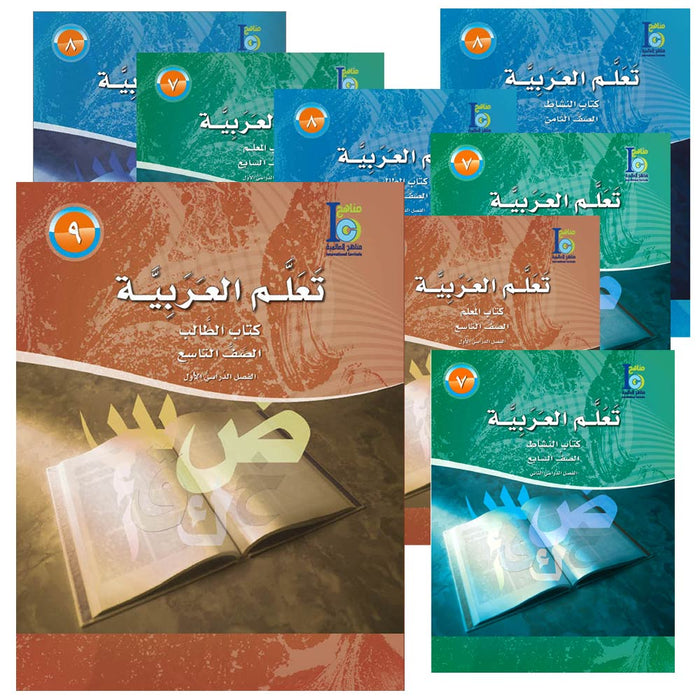Teaching language is a critical tool in communication and ultimately in the development of knowledge. In our quest to provide our customers with quality materials, we are pleased to offer the
Learn Arabic series. It employs modern methods of teaching foreign language to successfully teach the Arabic language to students in K-12th grade. This series was founded upon the following three fundamentals of teaching languages presented in an Islamic context:
- Elements: sounds, letters, phrases, and pronunciation
- Skills: reading, writing, speaking, and listening
- Linguistic Functions: introduction, greetings, description, requests, and apologies.
Series Contents: The
Learn Arabic series consists of textbooks, workbooks, and teacher’s manuals for levels K-12th grade. The textbooks aim to present basic elements of the Arabic language and their functions, while the activity books focus on enrichment material with special emphasis on writing. The teacher’s manuals offer tips on teaching Arabic efficiently with positive results.
Support Material:Teachers will be pleased with the full array of support materials available, such as a collection of audio records, posters, and cards. These books also include ideas for additional activities, such as chants, competitions, and linguistic plays. All of these materials will help to make each lesson exciting and active for students.
Student Textbook: The Student Textbooks are comprised of 24 units: 66 basic lessons of new material, plus an additional 6 units for revision. Each basic unit contains 4 lessons of new material, including dialog text, expressions, and vocabulary, and communication exercises. These units contain conversations, pronunciations and expressions, grammatical structures, listening, reading, thinking, writing, and extra activities, such as selections of Qur’an, ahadith and nasheed; where the teacher books include a midterm and final test. Answer keys can be found in the teacher's manuals.
Activity Book:
The activity book simply enhance the material found within the student textbooks. They mainly concentrate on writing skills with some review of verbal skills. Each contains many different activities which can be done at school or at home, such as coloring and painting pages; word matches; reading letters and sentences; writing words, letters, and numbers; and answering questions. Some of the activities should be completed at home with a parent to strengthen the relationship between home and school.
The curriculum will evantually contain grades from Elementary - High, currently you are in Middle and High School section; follow this link for your Elementary school students!
سلسة شاملة تعنى بتعليم اللغة العربية للأطفال و البالغين ، غير الناطقين بها . تعتمد هذه المجموعة على أحدث طرق التعليم و تحفيز تعلم اللغة العربية كلغة ثانية ، و تصعيد قدرة المهارات اللغوية الأربع (السمع ، النطق ، القراءة ، و الكتابة ) هذه السلسة تعرض العناصر اللغوية ، كالكلمات و المصطلحات و القواعد اللغوية ، عن طريق التمثيل بمواقف وقعية معيوشة .
تهدف سلسلة "تعلم العربية " من الروضة الى المستوى الثاني عشر إلى تعليم اللغة العربية للأطفال والشباب وفق أحدث الطرائق المعروفة في تعليم اللغات الاجنبية . وايمانا من مؤسسة مناهج بأهمية تعليم اللغة بوصفها أداة للتواصل الشفهي والكتابي ووسيله للحصول على المعرفة والمعلومات في شتى صورها تم التأكيد على الجانب الوظيفي للغة دون اهمال للمعلومات النظرية خاصة في المستويات المتقدمة وراعت هذه السلسلة تعليم اللغة من خلال المكونات الثلاثة :
- العناصر ( الأصوات ، والحروف والالفاظ والتراكيب)
- والمهارات الاربع ( الاستماع والتحدث والقراءة والكتابة (
- والوظائف اللغوية مثل (التقديم والتعارف والوصف والطلب والاعتذار(
مع تقديم كل ذلك في جو الثقافة الاسلامية من حيث الموضوعات الدينية والتاريخية والجغرافيه وغيرها اضافة الى ملامح من الثقافة العلمية المشتركه بين الامم المختلفة.
وتتألف كتب هذه المرحلة من:
- وثيقة منهج اللغة العربية.
- كتاب الطالب الجزئين الأول والثاني.
- كتاب النشاط الجزئين الأول والثاني.
- دليل المعلم الجزئين الأول والثاني.
- ICO Learn Arabic Textbook: Level 7, Part 1 (With Online Access Code) تعلم العربية
- ICO Learn Arabic Workbook: Level 7, Part 1 تعلم العربية
- ICO Learn Arabic Teacher Guide: Level 7, Part 1 تعلم العربية
- ICO Learn Arabic Textbook: Level 7, Part 2 (With CD) تعلم العربية
- ICO Learn Arabic Workbook: Level 7, Part 2 تعلم العربية
- ICO Learn Arabic Teacher Guide: Level 7, Part 2 تعلم العربية
- ICO Learn Arabic Textbook: Level 8, Part 1 (With Online Access Code) تعلم العربية
- ICO Learn Arabic Workbook: Level 8, Part 1 تعلم العربية
- ICO Learn Arabic Teacher Guide: Level 8, Part 1 تعلم العربية
- ICO Learn Arabic Textbook: Level 8, Part 2 (With Online Access Code) تعلم العربية
- ICO Learn Arabic Workbook: Level 8, Part 2 تعلم العربية
- ICO Learn Arabic Teacher Guide: Level 8, Part 2 تعلم العربية
- ICO Learn Arabic Textbook: Level 9, Part 1 (With Online Access Code) تعلم العربية
- ICO Learn Arabic Workbook: Level 9, Part 1 تعلم العربية
- ICO Learn Arabic Teacher Guide: Level 9, Part 1 تعلم العربية
- ICO Learn Arabic Textbook: Level 9, Part 2 (With Online Access Code) تعلم العربية
- ICO Learn Arabic Workbook: Level 9, Part 2 تعلم العربية
- ICO Learn Arabic Teacher Guide: Level 9, Part 2 تعلم العربية




































